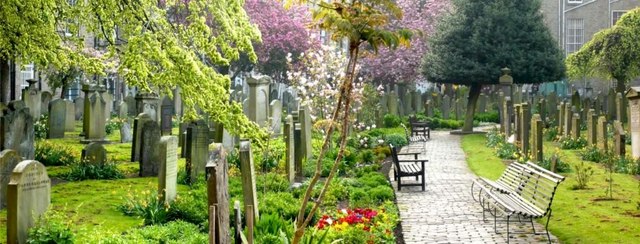The Howff



The Howff is a burial ground in the city of Dundee, Scotland. Established in 1564, it has one of the most important collections of tombstones in Scotland, and is protected as a category A listed building.[1]
History

The land of the burial ground was part of the Franciscan (Greyfriars) Monastery until the Scottish Reformation. In 1564 Mary, Queen of Scots granted the land to the burgh of Dundee, for use as a burial ground. It was used for meetings by the Dundee Incorporated Trades, and subsequently became known as The Howff, from the Scots word howff 'an enclosed open space, yard, area (as a timber yard)', likely related to German or Dutch hof 'enclosed space, courtyard'.[2]. Old parish records for burials within The Howff begin in the late 18th Century. Prior to this records of mortcloth hire, a cloth rented out by the Guildry and Trades to cover bodies or coffins before burial, provide evidence of burials dating back to 1655.[3] Meetings at The Howff ceased in 1776.[1] The last burial took place in 1878 (George Duncan). The walls along the west side date from 1601.[4]
The vault to the extreme south west (now simply saying "Blackness" inside) was the burial Vault of the Wedderburns of Blackness House in Dundee. A sealed window on its exterior appear to indicate this was either a watch-house or part of the original meeting-house prior to the vault being built (c.1630).
The graveyard is highly unusual by Scottish standards, containing a high number of Roman-style coffer tombs. It also contains a high number of inscriptions which philosophise on death itself rather than discussing the person interred.
Of the 80,000 burials in the Howff around 3% are classed as "foreign" but with many simply bearing this label due to birth at sea, reflecting Dundee's maritime heritage. As an odder distinction, some 10% of the deaths are specifically recorded as "Irish burials", largely labourers in the early 19th century.[5]
Burials

Burials at The Howff include:
- Alexander Bell (1776-1852) sugeon
- Thomas Bell (1759-1844) Provost of Dundee
- James Chalmers (1782–1853), printer, bookseller and inventor of the adhesive postage stamp
- Sir Alexander Douglas of Glenbervie (1738-1812)
- George Duncan (1791-1878), politician and last person to be buried in the Howff
- George Forrester (1635-1675) Dean of Guild in Dundee
- John Glas (1695–1773), clergyman and founder of the Glasite movement
- Clementina Stirling Graham
- James and Janet Keiller (1737-1813) creators of Keiller's marmalade
- Baron Jhone Kynnier (John Kinnear) (1511-1584)
- David Lindsay, 1st Earl of Crawford (c.1360-1407), interred in the now destroyed pre-reformation Greyfriars kirk. [6]
- John Lyon (1765-1814) botanist (memorial only)
- John Pitcairn (d.1800) Provost of Dundee
- Alexander Riddoch (1744-1822) Provost of Dundee
- John Scrymsour (sic) (1611-1657) Provost of Dundee
- The Wedderburn and Ogilvy-Wedderburn baronets of Balindean (multiple graves)
References
- ^ a b "The Howff: Listed Building Report". Historic Scotland. Retrieved 3 November 2011.
- ^ Dictionary of the Scots Language, s.v. howf, n1, v.
- ^ "Friends of Dundee City Archives - Mortcloth". www.fdca.org.uk. Retrieved 6 October 2017.
- ^ "The Howff". CANMORE. Royal Commission on the Ancient and Historical Monuments of Scotland. Retrieved 4 November 2011.
- ^ https://www.fdca.org.uk/Howff_Burials.html
- ^ James Balfour Paul, Scots Peerage, vol iii, p. 17. Edinburgh 1904
External links
- Tombs of the Dundee Howff
- The Howff site record at CANMORE, Historic Environment Scotland.
 Media related to The Howff at Wikimedia Commons
Media related to The Howff at Wikimedia Commons


